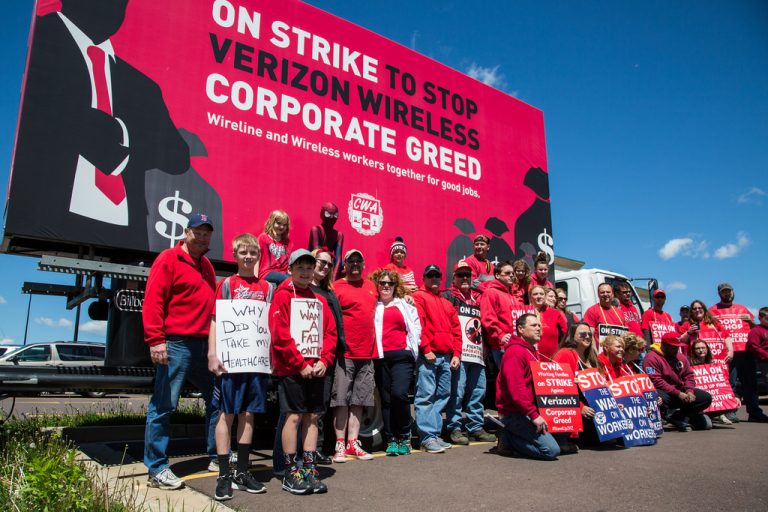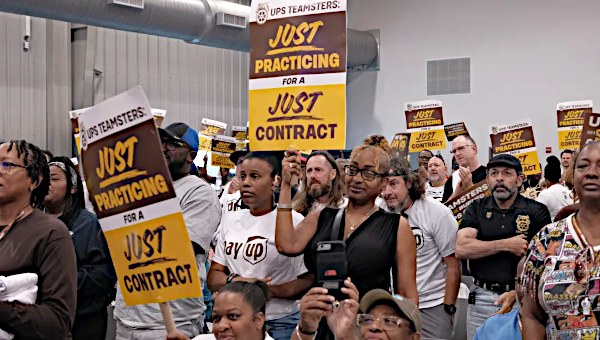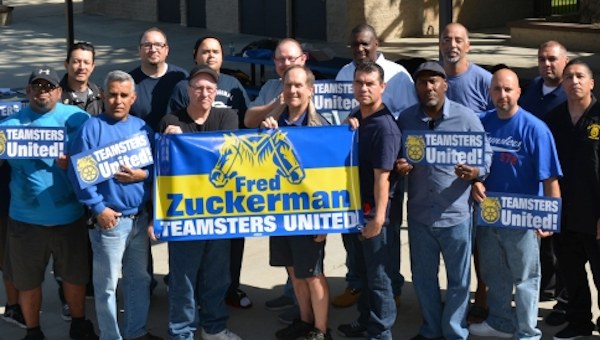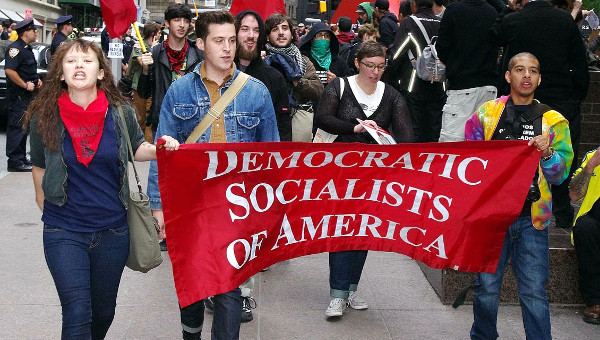The Political Revolution Goes to Work
The term “political revolution” is an odd one. Bernie Sanders never said that voting for him or building his campaign would overthrow capitalism (the traditional meaning of “revolution” in the socialist movement). The idea was radical but vague. It was rightly inspirational while what was actually asked of us was within the sphere of voting and elections, and in the Democratic Party at that.

Let’s define “political revolution” very broadly as left electoral campaigns that raise transitional demands and seek to enfranchise the disenfranchised. Bernie’s campaign, as well as those of followers such as Alexandria Ocasio-Cortez, called for radical reforms that the U.S. system could grant – Medicare for All, free public college – but which it is profoundly unwilling to. Raising the demands raises the question “why not?” and lays the blame squarely on Bernie’s “billionaire class.”
My argument here is a simple one: If we want a powerful movement, workers have to fight their employers not just at the ballot box but at the workplace, too. These two kinds of struggle can complement each other; union fights, in particular, pose clear class battles that raise consciousness. In addition to this year’s electrifying teacher strikes, we can learn from three other large-scale union victories that took place in the year before Donald Trump was elected. Those victories happened where we might least expect them: in the old, blue-collar economy, where unions are down to 6.5 per cent of the workforce and workers are said to be on their way out. Yet at Chrysler, Verizon, and a huge Teamster pension fund, thousands of union members organized to put a stick in management’s eye.
Few believed such victories possible as neoliberalism advanced steadily under Democratic and Republican administrations alike. These were not pocket-sized shop-floor wins but confrontations with big-time capital, from which hundreds of thousands of workers and their families have benefited. Together with this year’s teacher rebellions, they show what unions must do if they are to rebuild in the post-Janus era, and in one case they show how electoral politics and a working class battle can fortify each other.
An Atmosphere of Resistance
Any left political project fares better in an atmosphere of general resistance. Elections come only so often. We need agitation throughout civil society, in workplaces, neighborhoods, churches, at ICE (Immigration and Customs Enforcement) offices, on the National Mall in Washington. Compare what happens in a strike or even a contract campaign with what happens in an election. Even the best electoral campaigns, and we have seen some good ones recently, bend toward the lowest common denominator of political agreement. It’s all about the candidate, who is supposed to perform superhuman feats once in office. The campaign asks almost no involvement from the vast majority of people it tries to reach, nothing more than lever-pulling on election day. Campaign volunteers are generally given scripts, not a chance to self-start; in fact, they’re told to “stay on message.” Their tactics are largely limited to phone banking, door-knocking, and social media.
Fights with the boss, in contrast, can allow workers maximum opportunity to use their smarts and creativity. They are forced to get outside their normal sphere of silent resentment and take risks. They defy normal authority. They invent slogans, they strategize to find the boss’s weak points, and they plot escalating campaigns. They may confront scabs, they may break laws. They learn about power – what’s arrayed against them and their own.
Workplaces and the unions that organize them are two of the very few institutions that are socially integrated, where people of different races and backgrounds are forced to work together to get the job done. As such they are prime arenas for getting past the racism that is the worst weakness of the U.S. working class. In our three cases, workers could win only by putting interracial solidarity into practice. Regardless of how or whether they voted on election day, when it came to stopping givebacks workers stood together for a common goal.
Finally, fighting the boss can open workers up to left political ideas. Challenging authority sharpens the sense of class antagonism, and forging practical solidarity encourages love and friendship among one’s fellow fighters.
These results aren’t guaranteed, of course. Exit polls in 2016 showed 43 per cent of union household voters voting for Trump. Given the demographics of the teachers, Teamsters, telecommunications workers, and auto workers who won the fights described here, it’s likely that many did in fact choose Trump – just as many likely backed Bernie in the Democratic primaries.
Political Revolt, Class Revolt
This is where socialists come in. When socialists are inside workers’ fights, we can raise bigger ideas and counter bad ones. This is what happened in the historic wildcat strike of West Virginia teachers and school support workers last February. Sanders had swept all fifty-five counties in the 2016 Democratic Party primary, which put class politics in the air and prompted the growth of a Democratic Socialists of America (DSA) chapter in the state capital. When school workers walked out to save their health insurance, socialist teachers raised the idea that the money should come from a severance tax on the fossil fuel companies that had long exploited the state’s natural wealth.
Rallies at the capitol featured homemade signs demanding “Tax our gas!” and “Make a choice: Tax cuts for big business or health care for WV workers.” The legislature did not enact the tax, but the agitation made it impossible for politicians to drive a wedge between school workers and poor West Virginians by cutting services to pay for the raises they won. Rank-and-filers went on to compel the leaders of all three teachers’ unions to support the severance tax and oppose regressive taxes.
Another example of how political and class revolt can reinforce each other came during the 2016 primary season in New York, when a massive strike at Verizon coincided with the Sanders campaign. Communications Workers of America (CWA), the main union in the strike and one of the few to endorse Bernie, turned 150 strikers out for a Sanders rally on the strike’s first day. Sanders walked picket lines and blasted Verizon for destroying good jobs. When CEO Lowell McAdam called him “contemptible,” Sanders shot back: “I don’t want the support of McAdam, [GE CEO Jeffrey] Immelt and their friends in the billionaire class. I welcome their contempt.” Verizon was demanding big increases in health insurance premiums, so Bernie’s combative rhetoric and his call for Medicare for All found a receptive audience among the strikers.
Media attention buoyed strikers, garnered public support for both Sanders and CWA, and framed the strike as an expression of political resistance to the billionaire class. Sanders’s stump speeches on corporate greed resonated because workers were directly confronting a major corporation on the streets. The strike showed how political agitation combined with workplace action can channel workers’ anti-establishment anger toward the left instead of toward right-wing demagoguery. This is, in fact, what happened throughout Bernie’s primary campaign. Trump said, “You’re getting screwed? Punch down.” Bernie said, “You’re getting screwed? Join hands and together take on the billionaires like Trump.” His anti-corporate and pro-union campaign was strengthened when workers put his slogans into practice outside the electoral arena. It’s safe to assume that most of those strikers voted for Bernie.
Socialists Inside
The growth of DSA is good news at this juncture for the labor movement. While most DSA members (like most U.S. workers) aren’t in unions, chapters and regional gatherings are holding classes to bring them up to speed.
Some members are reinvigorating a socialist plan of action for union work that was called the “Rank and File Strategy” in previous decades. The first step is getting a job in a union workplace. New York City DSA’s local convention recently resolved to help interested members find union jobs (preferably in groups), connect them with experienced activists, and work on strategies for their unions. A new pamphlet from Young Democratic Socialists of America (YDSA) and the Democratic Socialist Labor Commission (DSLC) provides guidance for young members looking to become teachers, which would put DSAers in the heart of class struggles that are bound to erupt again.
Not Dead Yet
Like other public-sector workers, teachers will be hurt by the Supreme Court’s Janus decision, which will wreak serious damage on institutional labor. Janus makes the entire public sector right-to-work, with employees no longer required either to join the union that represents them or to pay a fee for that representation. As members quit, solidarity and finances will suffer.
But as the school worker rebellions showed us, workers need not be constrained by bad laws. The states where teachers went on strike in the first half of this year – West Virginia, Arizona, Kentucky, and Oklahoma – were already right-to-work, with no one obliged to join the union or pay fees. Public-sector strikes in all four states were illegal. In the first three, districts aren’t even required to bargain collectively with teachers. And yet these workers defied state laws to use labor’s oldest weapon, and they won overwhelming public backing and impressive raises. As Joe Burns, historian of the public employees’ strike wave of the 1960s and 1970s, writes: “Legality has a way of drifting into the background when workers organize en masse.”
Labor Notes published a special issue in July that showcases public- and private-sector unions that have maintained high membership rates in right-to-work states all along. They’ve done so by inculcating the idea that “the union” is a living and breathing presence at work every day, not just the headquarters and its staff. It’s “me and my co-workers keeping supervisors in line, enforcing our right to take breaks, making sure the new hires are welcomed and schooled.” An organization whose members know what it feels like to exercise power is an organization that workers will join, open shop or not.
Of course, such small-scale shop floor fights aren’t enough to defend workers as a class. They are the precondition for workers wanting to belong to unions and for gaining confidence that they can take on their employers. Then those unions can lead much bigger battles. At their best, these are waged on behalf of a larger constituency, as when nurses fight for smaller nurse-to-patient ratios in hospitals, or transit workers defend bus service, or when UPS Teamsters – a majority of them part-timers – sought public support for their strike for full-time jobs.
Campaigns in the private sector can be an essential part of the political revolution when they raise consciousness and seek solidarity around issues that affect our whole class. That’s the difference between a purely bread-and-butter campaign where workers go it alone and one that shows how we’re all in it together against a common class enemy.
Road Map to Resistance
The Chrysler, Teamster, and Verizon blue-collar upsurges all succeeded because of bottom-up initiatives. They also all had roots in union reform movements. The Verizon workers explicitly connected themselves to Sanders’s electoral campaign, to the benefit of each. The other two fights were missing the explicitly political link, but it’s easy to imagine how their unions could have opened their battles to supporters and asked for solidarity based on common interests, as I’ll suggest below.
No to Two-Tier at Chrysler: Since 2007 new workers in Big Three auto plants had hired on at half pay and worked alongside veteran workers on the same jobs, destined never to match “legacy” wages. Though United Auto Workers (UAW) leaders had told the Tier 2 workers in writing that their next contract, in 2015, would bring a section of them up to Tier 1 wages immediately, they reached an agreement with management that would continue the two-tier system indefinitely. The forty thousand Chrysler workers voted “no” nearly two-to-one. They forced union bargainers back to the table to negotiate a path to standard wages for all Tier 2 members.
No to Teamster Pension Cuts: Trustees of the mammoth Central States Pension Fund proposed to slash benefits for already retired workers by 50 to 60 per cent. In May 2016, 410,000 Teamsters, retirees, and their spouses in twenty-five states saw the fruits of two years of rank-and-file protests when a federal appointee bowed to their pressure and rejected the cuts. Two years on, retirees are still getting their full benefits.
No to Harassment and Outsourcing at Verizon: In 2016, thirty-nine thousand Verizon workers from Massachusetts to Virginia struck against the outsourcing of call center jobs, forced transfers to other states, and harassment and micromanagement of technicians. They ended their forty-five-day strike when management backed down from those practices, raised wages and pensions, added 1,300 union jobs, and granted first contracts at seven Verizon retail stores.
What Went Right?
The movements that produced these three victories shared one characteristic: grassroots action by tens of thousands of rank-and-file members. Not clever PR campaigns, not lobbying, not photo ops, but union members defying corporate power in big numbers. At Chrysler and the Teamsters pension fund, members were forced to organize against their own union officials as well. This was not an advantage, but it did ensure that workers weren’t hemmed in by excessive concern for courtesy or company profits.
Each time, the victories were partial. The improved Chrysler contract includes more use of temporary workers. The Teamster pension fund’s red ink still flows, and it still needs Congress to authorize a loan (Sanders has introduced a bill to do so). Verizon workers made concessions on health care costs.
Still, these workers can be proud of what they blocked and what they won. How did they beat the odds?
Power in Numbers
Workers in all three fights turned out big numbers for whatever they did.
At Chrysler, fired-up rank and filers generated tactics, confidence, and excitement through a plethora of Facebook groups where they posted contract details, pictures of their “no” ballots, and local vote results.
Members showed up en masse at union meetings and badgered the officials sent to sell the deal. They made “No More Tiers” T-shirts and wore them into the plants. A few dozen Detroit workers held a Vote No rally at UAW headquarters.
Teamster retirees formed local “Committees to Protect Pensions” in twenty cities, along with sixty Facebook pages. Retirees held letter-writing drives, visited congresspeople, and even picketed a newspaper to get a reporter’s attention.
Mass meetings of 300, 500, 800, 1200 were held from Milwaukee to Kansas City. At some, a government official got an earful about what the cuts would mean. Teamsters for a Democratic Union (TDU) and the Pension Rights Center helped to organize the work, and two thousand retirees from twenty states rallied in Washington in April 2016.
Verizon workers, too, turned out in big numbers: five hundred and eight hundred greeted the CFO and CEO, respectively, when they appeared at corporate conferences. The Good Morning America show hosted 250 strikers in their red T-shirts, and a rally in midtown Manhattan brought out 8,000 red shirts.
Hurt Profits
But the Verizon strikers also did the traditional thing a strike is supposed to do – stop work from getting done and disrupt profits.
Many strikes these days are “publicity strikes” involving one day on the picket line. The Verizon workers, in contrast, put up roving pickets every day. They harassed scabs and managers to make it difficult or impossible for them to install and repair phone lines. Verizon had to tell new fiber optic customers they would wait three or four months for service.
CWA didn’t hesitate to use rowdy tactics. When the company boarded scabs at hotels, strikers organized “wake-up calls” outside their windows in the wee hours of the morning. Locals recruited other unions and community groups (some as far away as California) to adopt Verizon retail stores to picket. Strikers recruited New York health care unions for a day of action to protest Verizon’s cutting off health benefits.
Verizon workers earn far above the blue-collar norm. Strikers who’d been worried about public resentment reported honks of support and picket-line deliveries of pizza and coffee instead. Meanwhile, CWA members had a strike fund behind them, with benefits of $200-$300 a week and a promise to pay medical bills. As the strike wore on, analysts predicted hundreds of millions of dollars in lost profits. Verizon caved, and the strikers won.
How to Make a Fight Political
The Chrysler workers, whose rank-and-file fight against two-tier was spontaneous, simply didn’t have the resources to take it public as the Verizon workers did. We have another model, though, for what such a campaign – in the private sector, on behalf of particular workers – could have looked like. In 1997 the reform leadership of the Teamsters took on UPS with a two-week strike for full-time jobs, under the slogan “Part-Time America Won’t Work!” Members not only stopped UPS’s profit machine, they also were organized to speak to the press and to go out and talk with their regular customers. A Gallup poll showed the public supporting the strikers by a two-to-one margin.
If the UAW had wanted public support against Chrysler, how about a slogan like “Two-Tier America Won’t Work”? The union could have appealed to other workers’ basic sense of fairness – and to their experiences with two-tier wage systems in their own workplaces – to bring political and consumer pressure to bear on Chrysler. GM and Chrysler worked hard to convince the public that they deserved the massive 2009 federal auto bailout. The union could have taken its case against two-tier to the public, too, but it didn’t do so.
This is the kind of outward-facing campaign with class-wide demands the Left should support as part of the political revolution we’re fighting for.
Size Matters
After Janus it’s not surprising to hear the view, from labor’s friends and foes alike, that existing union members are dinosaurs, concessions are inevitable, and the labor movement is on its way out. Some have argued that labor’s best hope is to focus on the most vulnerable workers (i.e., fast-food workers, Uber drivers), though it’s not clear why they should want to hop on a sinking ship. “Alt-labor” theorists have spilled much ink about the advantages of worker centers, a much looser form of organization that generally recruits immigrants in low-paid jobs.
But these three battles show that the raw material is still there for big fights led by private-sector unions, those with the power to stop production in the heart of the economy.
Democracy Matters
These fights also showcase the fruits of union democracy movements.
In the UAW, where modern concessions began in 1979, each new round of union-agreed givebacks has been met by a wave of worker resistance, reaching a high point in the 1980s in the New Directions Movement. Victor Reuther, a UAW founder, even came out of retirement to help lead the fight against company-union collaboration. These earlier protesters won members the right to an informed vote, so that the entire 2015 contract was available online.
Today there is not much organization in the UAW between contracts, but the legacy of resistance survives in rank-and-filers’ belief that they have a right to say “No.” The Teamsters for a Democratic Union (TDU), founded in 1976, is now the only substantial national union reform movement. Tactical, logistical, and networking assistance from TDU was critical to the retirees’ organizing. The opposition movement is going strong: In the November 2016 election for top officers, dissidents won a slim majority among U.S. members, falling behind to 48.5 per cent only because of voters in Canada. Teamster president James Hoffa was soundly outvoted in the 25 states that belong to the Central States Pension Fund.
And in the CWA, the flagship Verizon local in New York was led by reformers who pushed national officers to call the open-ended strike, after a failed two-week strike in 2011. It helped that CWA activists from all over had built prior connections at the day-long meetings they hold at the national conference of Labor Notes, the magazine founded to give voice to union reform movements.
Power of a Good Example
Fights like these inspire others to want unions of their own. Even former AFL-CIO president John Sweeney saw the recruitment power of workers acting on their own behalf. When the Teamsters beat UPS in 1997, Sweeney said, “You could make a million house calls and run a thousand television commercials and stage a hundred [farmworker] strawberry rallies, and still not come close to doing what the UPS strike did for organizing.”
Such a stance was unusual for Sweeney and for most top union leaders today, who typically prefer to make concessions to powerful employers rather than mobilize members for a fight. But in today’s open-shop America, using union power is the best way to inspire existing members to stay in and to inspire more workers to join.
Much of the post-Janus discussion has centered on the harm that will be done to unions’ political operations as members quit and treasuries are depleted. Anti-union forces have crowed that they can convince 5 to 20 per cent of union members to leave, their goal being to hamstring unions’ ability to get out the vote for Democrats.
Unions are preparing scripts for staffers, arming them to convince members to opt in by comparing the cost of dues to that of a cup of latte. At this year’s Labor Notes conference, Massachusetts Teachers Association President Barbara Madeloni reminded us that if union leaders rely only on arguments about what the union “provides” to members, they’ll lose. But if they enable members to experience the power of a union, Madeloni said, appeals to quit won’t hold water, because you can’t argue away the feeling that comes from using power.
Workers who are uniting to confront power on their own behalf become open to left politics, if those politics are on the table. It’s our job to make sure both are happening. •
This article first published on the Socialist Forum/DSA website.





